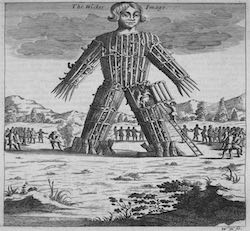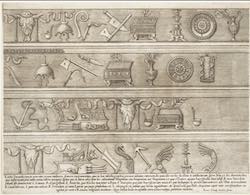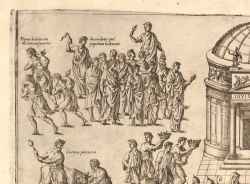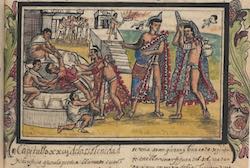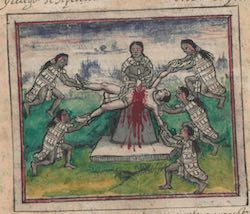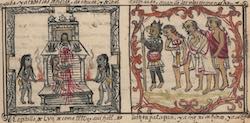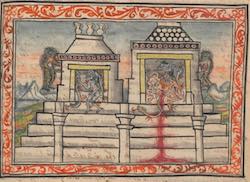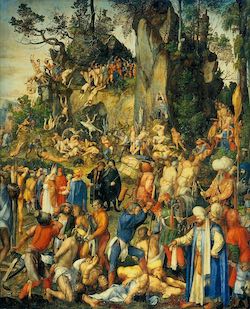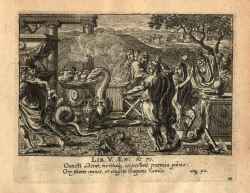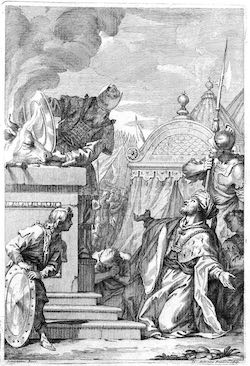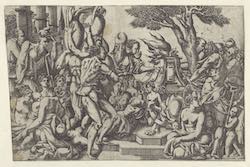Topic: 2. Sacrifice and religion: Comparisons, Antiquarians, Anthropology (16th-18th Century)
Religious sacrifices across various cultures and contexts sparked widespread interest in Early Modern Europe. As Christianity expanded into regions inhabited by "infidels" and "pagans", Europeans encountered a diverse array of sacrificial customs, ranging from the Sati rituals in India to the Aztec sacrifices in the Americas. This cross-cultural exposure captivated a wide audience, including theologians, philosophers, political thinkers, antiquarians, orientalists, missionaries, poets, artists, and even the general public. These encounters broadened the European understanding of sacrifice and led to a critical reassessment of classical and biblical sacrificial rites. This section includes:
- Sources: A selection of early modern printed materials, which include descriptions of the Americas, Asia, and Africa, alongside antiquarian and philological studies on religious sacrifice in classical antiquity and beyond. It also presents early modern works of ethnological observations and the first attempts to compare different sacrificial practices in various traditions and contexts, laying the groundwork for disciplines like the history of religions and anthropology.
- Iconographic Representations: A rich collection of images from the 16th to 18th centuries, illustrating a range of sacrificial rituals and practices as seen in different cultural and geographical contexts.
- Related Bibliography: An extensive bibliography spanning scholarly works from the 19th to 21st centuries, providing contemporary analyses and interpretations of these early studies and observations.
The Wicker Image (1676)
from: Aylett Sammes, Britannia Antiqua Illustrata, London, 1676, facing page 105
Frieze of Sacrificial Instruments (1580 - 1585)
from: Lafréry, Antoine. Speculum Romanae Magnificentiae [...], Roma, n. p., 1553, A 128
University of Chicago Library, Chicago
Suovetaurilia; at right bulls, rams and boars being brought towards the altar positioned in front of the entrance of a circular temple, various animals being sacrificed to left. (1566)
from: An illustration to Onofrio Panvinio's 'De Ludis Circensibus', published in Rome
The British Museum, London
Aztec Human Sacrifice (1579)
from: Diego de Duran, Historia de las Indias de Nueva España e islas de la tierra firme, 1579, c. 75r
Aztec Human Sacrifice on the Altar (1579)
from: Diego de Duran, Historia de las Indias de Nueva España e islas de la tierra firme, 1579, c. 238r
Aztec Sacrifice to thank Gods for the Vistory (1579)
from: Diego de Duran, Historia de las Indias de Nueva España e islas de la tierra firme, 1579, c. 138r
Aztec Temple with Hung Skulls (1579)
from: Diego de Duran, Historia de las Indias de Nueva España e islas de la tierra firme, 1579, c. 232v
Dedication of a New Temple to Coatl God (1579)
from: Diego de Duran, Historia de las Indias de Nueva España e islas de la tierra firme, 1579, c. 170v
Human Sacrifice for the Toci Goddess (1579)
from: Diego de Duran, Historia de las Indias de Nueva España e islas de la tierra firme, 1579, c. 181r
Human Sacrifice in front of an Aztec Pyramid (1579)
from: Diego de Duran, Historia de las Indias de Nueva España e islas de la tierra firme, 1579, c. 280v
Human Sacrifice on Pyramids with Aztec Gods (1579)
from: Diego de Duran, Historia de las Indias de Nueva España e islas de la tierra firme, 1579, c. 131r
Sacrfice and Revenge among the Aztecs (1579)
from: Diego de Duran, Historia de las Indias de Nueva España e islas de la tierra firme, 1579, c. 70r
Transport of the Sacrificial Stone (1579)
from: Diego de Duran, Historia de las Indias de Nueva España e islas de la tierra firme, 1579, c. 189v
Two Aztec do Sacrfice offering Incense and cutting the Body (1579)
from: Diego de Duran, Historia de las Indias de Nueva España e islas de la tierra firme, 1579, c. 248v
https://iconographic.warburg.sas.ac.uk/object-wpc-wid-diaw (1535)
from: Italy
National Gallery of Art, Washington
Martirio dei Diecimila (1507)
Vienna, Kunsthistorisches Museum
Aeneas sacrifices at the tomb of Anchises, a giant snake winds around the altar (1688)
from: Peplus virtutum Romanarum in Aenea Virgiliano eiusque rebus fortiter gestis, ad maiorem antiquitatis et rerum lucem, communi iuventutis sacratae bono, aere renitens) (Nuremburg: J.L. Buggel, 1688), pl. 18.
Münchener DigitalisierungsZentrum
Pagan sacrifice (17th)
from: Catalogo generale dei Beni Culturali
Pinacoteca Nazionale di Bologna, Gabinetto dei Disegni e delle Stampe
Sacrificial scene inspired by a work of Rosso Fiorentino (1542)
Rijksmuseum, Amsterdam

